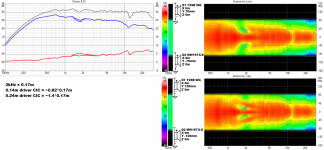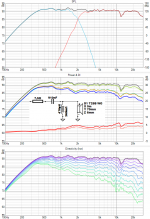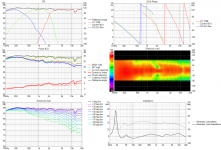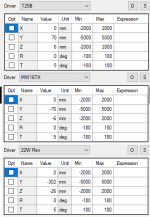I assume you refer to the power response dip. It is caused by vertical behaviour. When I remove verticals from the calculation the dip dissappers. There is vertical polar map showing off-axis dips at Fc.
Try to move centers in Vituix closer and further apart at vertical axis and monitor what happens.
What is the cause of the "waistband" @2kHz?
Pretty unavoidable, being the vertical response of two drivers spaced separately on the vertical plane. Horizontal map would be perfect probably. A trait of almost every speaker in existence that isn't using coaxial drivers.
Zvu, good idea for the study. Shamal baffle is 5deg tilted, but for this case of study I made it straight baffle and tuned the crossover so drivers sum 6dB at Fc.
Study shows:
1. 140m drivers CtC, this is current state
2. 240mm drivers CtC, this provides improvement to power response and flatenning of DI. I think this confirms what Kimmo siad in other thread about CtC and ~1.5x wavelength at Fc.
CtC <140mm only worsened both power and DI so not mentioned in the graphs.
Unfortunatelly larger CtC are not visually acceptable for me. ~170mm would still look ok.
Study shows:
1. 140m drivers CtC, this is current state
2. 240mm drivers CtC, this provides improvement to power response and flatenning of DI. I think this confirms what Kimmo siad in other thread about CtC and ~1.5x wavelength at Fc.
CtC <140mm only worsened both power and DI so not mentioned in the graphs.
Unfortunatelly larger CtC are not visually acceptable for me. ~170mm would still look ok.
Try to move centers in Vituix closer and further apart at vertical axis and monitor what happens.
Attachments
Unfortunatelly larger CtC are not visually acceptable for me.
A large CtC taken to the extreme:
Attachments
Shamal baffle is 5deg tilted back => Z 6mm for tweeter and Z -6mm for mid. Ref axis is in the middle.
Pida, nice speaker! Out of curiosity, how'd you come up with exactly 2000Hz crossover point? Most of the time when tuned to the measurements the crossover ends up being something like 2053Hz or 1942Hz than exactly 2000Hz. The reason I'm wondering is if anybody else has noticed this or is there other reasons using exact number other than it is a beautiful looking number?😀
Last edited:
tmuikku: 2000Hz was just initial target based on T25B distortion rising below 2000Hz, and MW16TX directivity and breakup above 2000Hz.
I do not use any crossover optimizers, I do all by hand. Hitting 2000Hz crossover exactly was just a luck. In the case graphs would not look good for this Fc around 2000Hz, I would modify filters to lower or higher Fc. So I am not chasing 2000Hz exactly. I would be happy with anything close around providing good graphs.
I do not use any crossover optimizers, I do all by hand. Hitting 2000Hz crossover exactly was just a luck. In the case graphs would not look good for this Fc around 2000Hz, I would modify filters to lower or higher Fc. So I am not chasing 2000Hz exactly. I would be happy with anything close around providing good graphs.
Last edited:
Zvu, good idea for the study.....
In what increments did you test to get the best result that yielded 240mm CtC distance, a cm at a time ?
That's about 1,4xWL@Xo
I tried 20mm increments. Going down with CtC from current 140mm made situation worse. Going up with CtC showed improvements of power and DI, and I chose to show situation for CtC 240mm because it brought noticeable improvement ~1dB. I did not go further, I was not looking for optimum, just wanted to see what direction things go, and CtC 240mm is already too much for me to accept for any design with similarly large drivers.
Nice job and promising measurements. What are your preliminary feeling about the combo mw16tx and t25b ? Have you tried the integration of the 22W ?
nanou: MW16TX and T25WG measure and match very well, looking at the preliminary modelling. I assume sonically they will match well too. What I am libble bit worried is if Satori matches sonically well to Revelator, I had some issues with this in the past. But I am starting to account that partially to the room. I will have a chance to tune and listen to these speakers in new room in ~5months, so final tuning and listening will have to wait. Of course I will wire it earlier in current room, my curiosity will not let to wait and just look at it.
So today I took measurements for crossover design, and modelled the first version. I am very happy with the results so far. And the dip at 13kHz does not look good, but it is only -3dB and very narrow, I will try some experiment to improve that, later, but I assume the dip will not have significant impact on sound quality.
Modelling done in Vituix v2, graphs contain vertical measurements.
Modelling done in Vituix v2, graphs contain vertical measurements.
Attachments
Last edited:
Looking good! I guess the 13 kHz issue is happening in the waveguide. I wouldn't worry too much about it.
Did you take full 360° acoustic measurements, both horizontally and vertically? At what angular steps?
Did you take full 360° acoustic measurements, both horizontally and vertically? At what angular steps?
I took horizontal measurements 0-90deg, in 10deg steps. Vertical measurements are not needed with Vituix v2.
I took horizontal measurements 0-90deg, in 10deg steps. Vertical measurements are not needed with Vituix v2.
Hello Petr,
Could you develop why, in VituixCAD 2, vertical measurements are not needed to fully characterize a design ?
Vituix mirrors horizontal measurements of each driver to vertical measurements (circular drivers). This is why v2 method requires horizontal set of measurements to be taken at the elevation of each individual driver.
To enable vertical polar pattern calculation, XYZRT coordinates of each driver have to be filled in.
When these prerequisities are done, Vituix "manipulates" individual drivers responses to calculate the result in virtual mic position. This is powerful feature, as it allows to design quite complex loudspeaker, with multiple woofers etc. Common mic position has its limitations and the results are not accurate.
Important note: all my measurements are done dual channel to get measured drivers phases right. Coordinates here represent positions of drivers on the front baffle and related to ref position. Coordinates here are not about acoustic centers.
To enable vertical polar pattern calculation, XYZRT coordinates of each driver have to be filled in.
When these prerequisities are done, Vituix "manipulates" individual drivers responses to calculate the result in virtual mic position. This is powerful feature, as it allows to design quite complex loudspeaker, with multiple woofers etc. Common mic position has its limitations and the results are not accurate.
Important note: all my measurements are done dual channel to get measured drivers phases right. Coordinates here represent positions of drivers on the front baffle and related to ref position. Coordinates here are not about acoustic centers.
Attachments
Last edited:
That was fully understood, but in real situation (ie a loudspeaker like yours) in no way the vertical set of each driver will be the same as the horizontal one due to fact that edges seen from each driver will not be the same in the +/- vertical plane.
To my understanding, XYZ drivers coordinates are used to compute the result for mic location in VituixCAD. Maybe I am wrong ?
To my understanding, XYZ drivers coordinates are used to compute the result for mic location in VituixCAD. Maybe I am wrong ?
- Home
- Loudspeakers
- Multi-Way
- New project: 3way 22W/4851, MW16TX-8, T25B in WG




